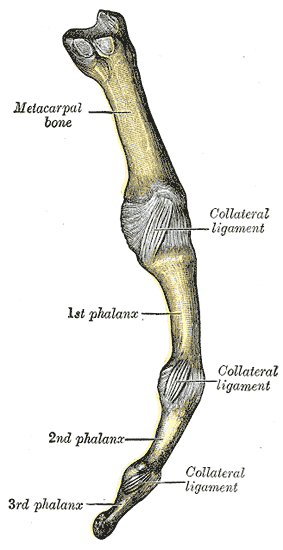Annular ligaments of fingers
(Redirected from Pars anularis vaginae fibrosae digitorum manus)
Annular Ligaments of Fingers[edit | edit source]
The Annular Ligaments of Fingers are a set of ligaments found in the human hand. They are part of the flexor tendon sheath and play a crucial role in the movement and flexibility of the fingers.
Anatomy[edit | edit source]
The annular ligaments, also known as A1 to A5 pulleys, are five fibrous bands that encircle the flexor tendons of the fingers. They are named for their ring-like structure, with "annular" deriving from the Latin word annulus, meaning ring.
The A1 pulley is located at the base of the finger, the A2 pulley is found in the proximal phalanx, the A3 pulley is located at the level of the proximal interphalangeal joint, the A4 pulley is found in the middle phalanx, and the A5 pulley is located at the distal interphalangeal joint.
Function[edit | edit source]
The primary function of the annular ligaments is to hold the flexor tendons close to the bones of the fingers, allowing for efficient finger flexion. They also prevent bowstringing of the tendons during finger flexion, which would otherwise limit the range of motion and strength of the fingers.
Clinical Significance[edit | edit source]
Injury to the annular ligaments can result in a condition known as trigger finger, where the finger or thumb gets stuck in a bent position. This condition is caused by inflammation or swelling of the flexor tendon sheath, which narrows the space within the sheath and makes it difficult for the tendon to glide smoothly.
See Also[edit | edit source]
References[edit | edit source]
Search WikiMD
Ad.Tired of being Overweight? Try W8MD's physician weight loss program.
Semaglutide (Ozempic / Wegovy and Tirzepatide (Mounjaro / Zepbound) available.
Advertise on WikiMD
|
WikiMD's Wellness Encyclopedia |
| Let Food Be Thy Medicine Medicine Thy Food - Hippocrates |
Translate this page: - East Asian
中文,
日本,
한국어,
South Asian
हिन्दी,
தமிழ்,
తెలుగు,
Urdu,
ಕನ್ನಡ,
Southeast Asian
Indonesian,
Vietnamese,
Thai,
မြန်မာဘာသာ,
বাংলা
European
español,
Deutsch,
français,
Greek,
português do Brasil,
polski,
română,
русский,
Nederlands,
norsk,
svenska,
suomi,
Italian
Middle Eastern & African
عربى,
Turkish,
Persian,
Hebrew,
Afrikaans,
isiZulu,
Kiswahili,
Other
Bulgarian,
Hungarian,
Czech,
Swedish,
മലയാളം,
मराठी,
ਪੰਜਾਬੀ,
ગુજરાતી,
Portuguese,
Ukrainian
Medical Disclaimer: WikiMD is not a substitute for professional medical advice. The information on WikiMD is provided as an information resource only, may be incorrect, outdated or misleading, and is not to be used or relied on for any diagnostic or treatment purposes. Please consult your health care provider before making any healthcare decisions or for guidance about a specific medical condition. WikiMD expressly disclaims responsibility, and shall have no liability, for any damages, loss, injury, or liability whatsoever suffered as a result of your reliance on the information contained in this site. By visiting this site you agree to the foregoing terms and conditions, which may from time to time be changed or supplemented by WikiMD. If you do not agree to the foregoing terms and conditions, you should not enter or use this site. See full disclaimer.
Credits:Most images are courtesy of Wikimedia commons, and templates, categories Wikipedia, licensed under CC BY SA or similar.
Contributors: Prab R. Tumpati, MD

